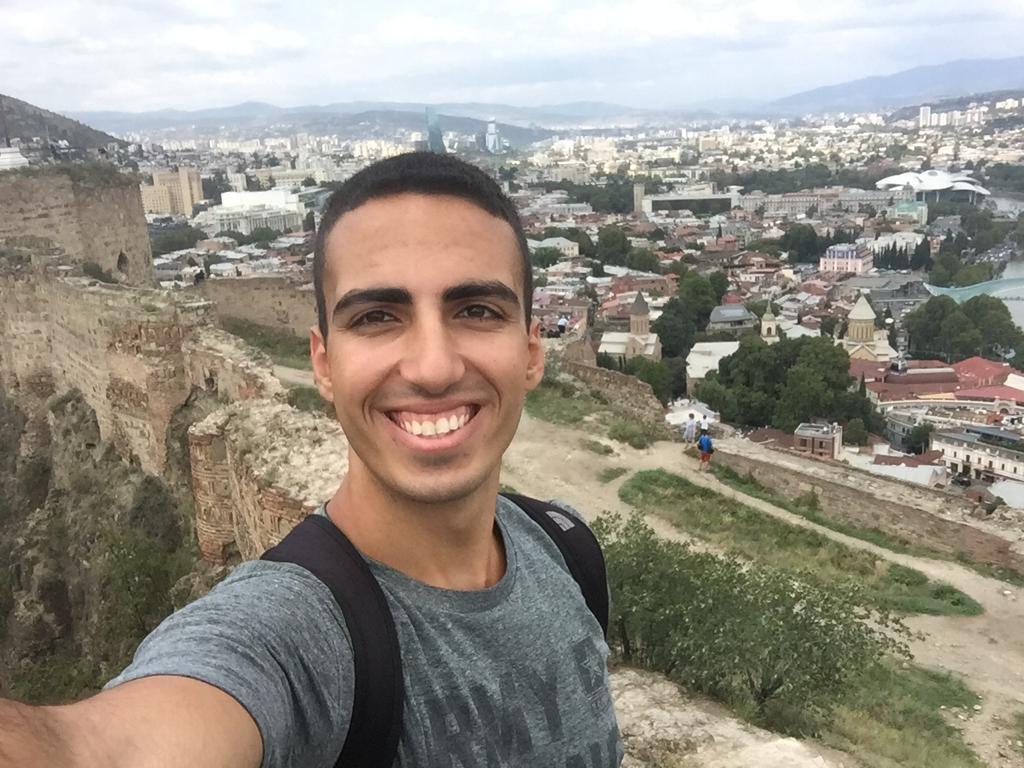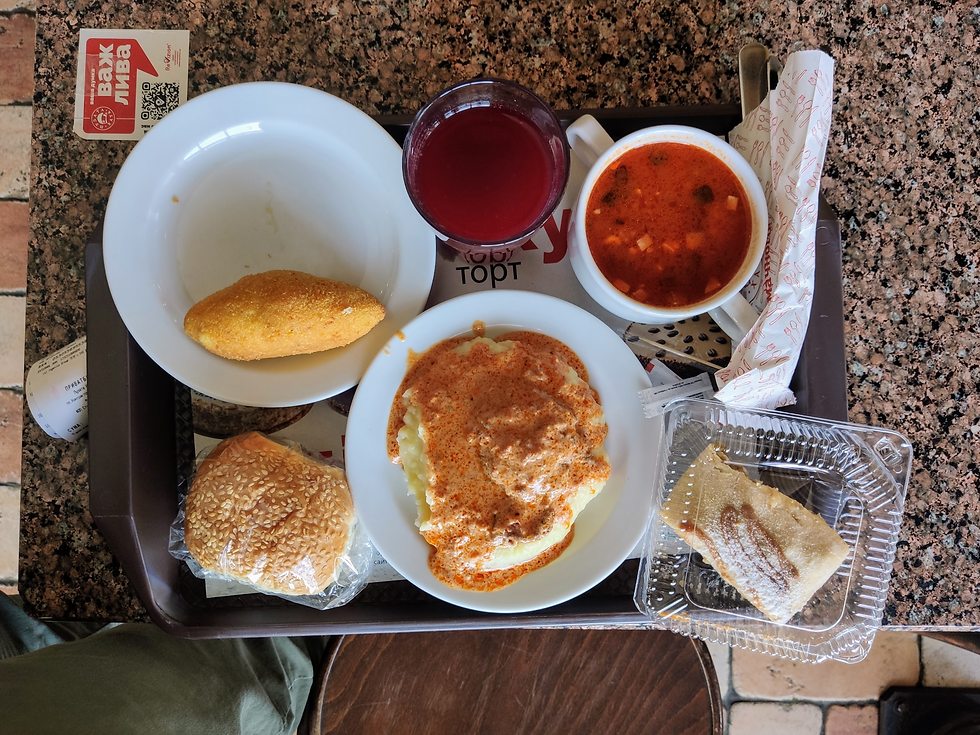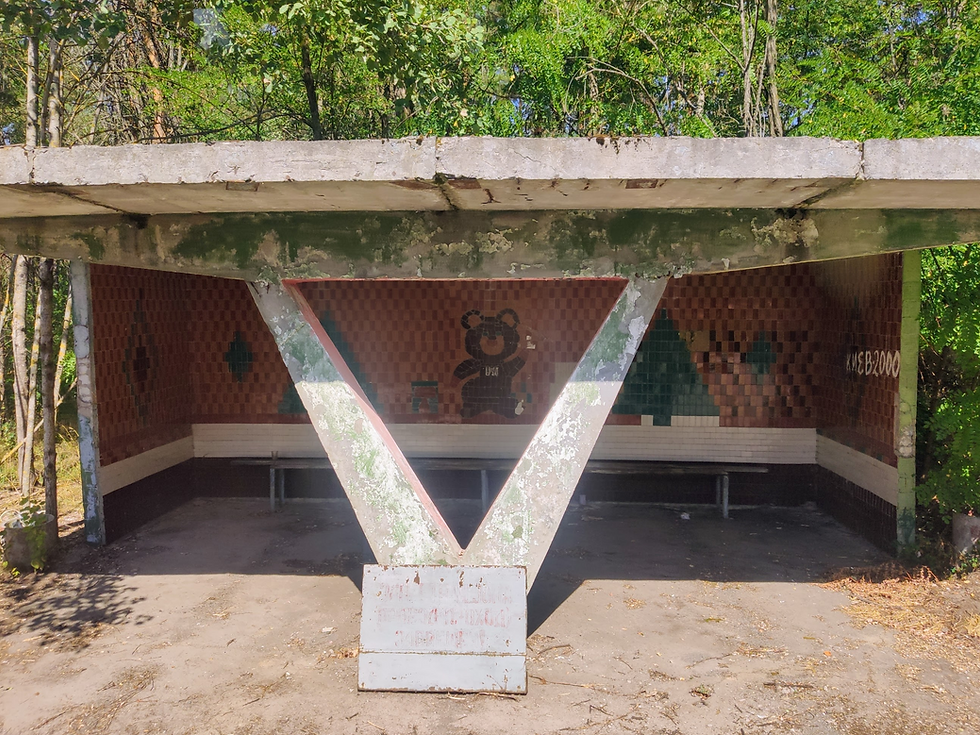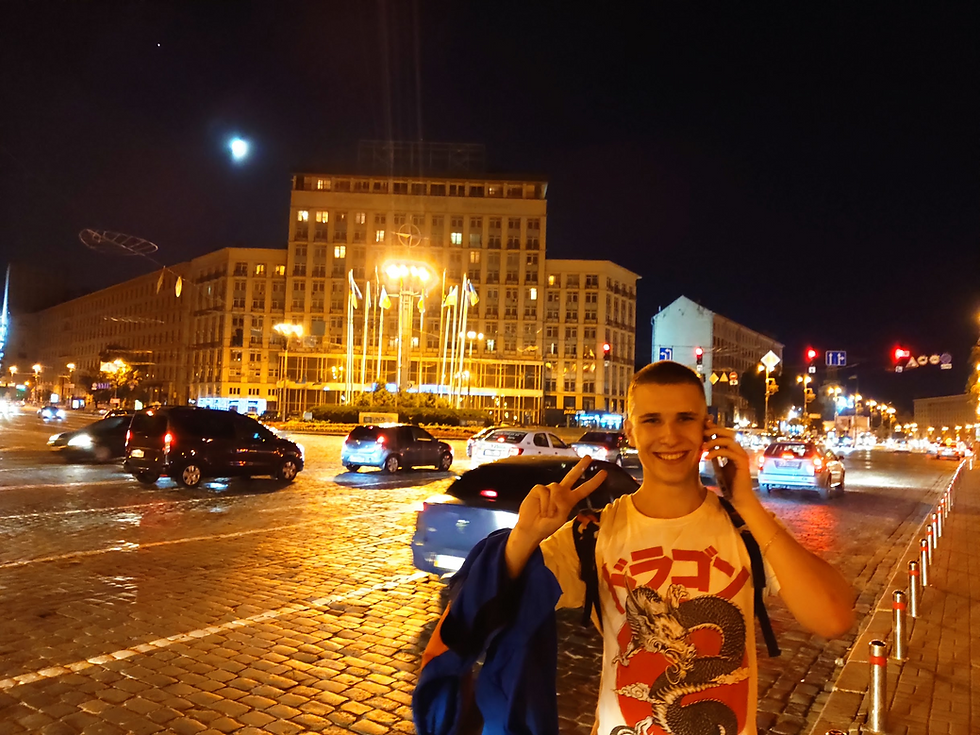Kyiv: Orthodox Churches, Captain Gopnik, and a Visit to Chernobyl
- Aaron Schorr

- Aug 26, 2021
- 14 min read
We had a bus at 10:30 to the capital, and showed up several minutes ahead of time to the bus terminal. There were buses headed to Odessa, Mykolayiv, Kherson, and Prague, but none to Kyiv. I entered the office to ask where our bus was, and was referred to the head dispatcher, a woman with a white bob sitting in an office surrounded by bus schedules and dot-matrix printouts, like something from a “how things work” book from last century. In bad Russian, I gave her the name of our bus company and destination and asked if she knew where the bus was. "Десять тридцать?” (Ten-thirty?) “Да”. She handed me a slip of paper with the vehicle’s plate number, which turned out to be a better-organized marshrutka, though it did leave 15 minutes late.
The entrance to Kyiv was a four-lane mess of trucks, buses, and billboards. We were welcomed to the city by a huge metal sculpture of a cross-bearing robed Orthodox saint with the letters КИЇВ (Kyiv) and arrived at the very modern-looking bus station south of the city center. The fact that we were in a big city was immediately apparent, as some of the first people of color (with the exception of Arkadia Beach) were visible on the short walk to the rather grand metro station. We had to buy transport passes, and a woman in a very official-looking uniform came up to me and started measuring every dimension of my bag with a tape measurer. I had no idea if she was satisfied or not, jabbering away in Ukrainian with a severe face, but she walked away. Passes in hand, we walked through the turnstiles and I received the same treatment again from another attendant in a very Soviet-style welcome to the city. The subway trains, painted in Ukraine’s national colors, were almost unbelievably loud, making conversation completely impossible until we alighted in the old town.

After checking into our hostel, we needed some lunch. Across the street was a branch of Puzata Chata, a chain of Soviet-style stolovayas (canteens) serving local food cafeteria-style. I had discovered these in Vladivostok last winter, and they were one of my favorite forms of restaurant: you get a tray, pick different dishes that you want from the invariably stern-faced lunch ladies, and sit at a table to eat with your friends. I filled my tray with mashed potatoes and chicken stew, some sort of meat soup, apple strudel, and Chicken Kyiv, an apparently well-known worse version of schnitzel that, like seemingly everything made behind the Iron Curtain, was simply not crispy enough.

Churches on Churches
The square in front of the canteen had a huge Ukrainian flag on its side with the phrase Слава Україні! Героям слава! (Glory to Ukraine! Glory to the Heroes!) printed on it. We would be seeing a lot of this phrase, which is used by Ukrainian patriots to express pro-Ukrainian sentiment (or simply anti-Russian sentiment, as the two are rather complimentary these days). Its past is somewhat controversial, used by various Ukrainian nationalist organizations throughout the 20th century - some of which were very far to the right - and made illegal in the USSR, but it's something of a national slogan in today's Ukraine. As if to complete the picture, military aircraft kept overflying us all afternoon in formation, some even dropping flares and paratroopers over the city in preparation for the upcoming Independence Day.

We walked up St Andrews Descent past little stands selling Soviet memorabilia - pins, posters, and watches - with the occasional Nazi memento thrown in. One memorable stand was selling fake Ukrainian driver’s licenses bearing the names and faces of world leaders including Putin, Erdogan, the Pope, and even Hitler. We took a detour from the main road and climbed up some metal stairs that looked exactly like Budapest to get a view of the city.
At the top of the hill was the beautiful 18th-century St Andrews Church, again painted in Ukraine’s national colors. I spotted a gorgeous Soviet pilot’s watch and started negotiating a price with its seller, seriously tempted to buy it. Fortunately, Bilal turned out to be an expert on Soviet watches and declared it to be a low-quality replica which was not worth my money.
The next landmark was Sofiyivka Square (which also looked like Budapest), named for the St. Sophia Cathedral behind it. There was a statue of a horseman in the square, and I said he looked like he was an anti-Semite. Boy, was I right: the statue depicted Bohdan Khmelnytsky, the 17th-century Cossack nobleman responsible for the deaths of tens of thousands of Jews under his rule.
We bought tickets to visit the cathedral and were hit with the overpowering stench of incense as we entered one of the side buildings, with lots of heavy, golden Orthodox icons on display. The main cathedral was originally built in the 11th century by Yaroslav I the Wise, Grand Prince of Kyiv, and is named after him. The walls were all covered in beautiful frescoes, although many of them were rather faded, and there was a large gilded altarpiece in the center. Interestingly, there were lots of Old Testament scenes on display, which I was not used to seeing in European churches. It was very evocative of the cathedral we had visited in Chisinau, only much bigger and older.
Our final stop on our church tour was the Golden Gate, an utterly bizarre structure at the edge of the old town. The structure is a 1982 reconstruction of one of the city’s original gates with a church plopped on top, only the Soviet authorities didn’t really know what the original one looked like. The result is a monstrosity that looks like Noah’s Ark if it had been in the Star Wars universe, but it made for a great spot to unwind at the end of the day.
Welcome to the Exclusion Zone
The following day was reserved for visiting Chernobyl. Traveling to the disaster area is essentially only possible with an organized tour, which costs $100 for a one-day trip, but I hadn't come all this way to skip Chernobyl. We took an early bus to the train station and found our bus for the day. It was a two-hour drive through impenetrable pine forests until we got to the first checkpoint to enter the Exclusion Zone, which stretches across a Luxembourg-sized swath of northern Ukraine. Visiting Chernobyl has really taken off in recent years, no doubt in part due to the HBO series about the disaster and video games like S.T.A.L.K.E.R and Call of Duty which have made the Soviet nuclear disaster aesthetic much more mainstream than it reasonably deserves to be. The result was an absurd proagation of this aesthetic, from the fake-irradiated signs sold as souvenirs to the inexplicable APC parked by the checkpoint emblazoned with our tour company’s logo. Worst of all were the guides, who all wore different forms of special-forces-esque gear straight out of a video game - ours both went for the green cargo pants and black baseball caps, but others were dressed in full camouflage gear with name patches and duty belts as if they were in Fallujah.
We were issued entry passes, dosimeters, and Geiger counters, and entered the Zone. Our first stop was Zalissya, a small village south of Chernobyl abandoned during the evacuation. The village was favored by the Soviet government, so it had a number of private cars and most of its buildings were brick, which means they have survived mostly intact to this day. We walked through homes with collapsed roofs to the pearl of the village, a town hall with still-standing Communist banners and a half-collapsed wooden floor with vines growing through it. I walked around the building to a small garden and suddenly found a 3-inch spider on my chest which almost made me faint - I wasn’t quite in the mood to become the Chernobyl Spiderman. I don’t think anything will ever outdo the Abkhaz Parliament in terms of raw and authentic abandoned beauty, but this came pretty damn close.
The next step was even more targeted at my interests. After the US deployed its first ICBM - the SM-65 Atlas - in the early 1960s, the Soviets decided that they needed a way to detect American ballistic missile launches early enough to launch a counterstrike before their land-based missiles were wiped out. The result was Дуга (Duga), a shortwave radar of colossal dimensions designed to monitor the airspace high above the United States and provide adequate warning of an American missile launch. The first operational unit was constructed in Chernobyl to monitor the East Coast, and the second in Khabarovsk (9 hours north of Vladivostok on the Trans-Siberian) for the West Coast. The project was mostly a failure, since the radar was so powerful that it created RF interference throughout Europe (including for the Soviets’ own communications) and was made obsolete by satellites by the time it was in working order in the late 70s. Duga-2 in Khabarovsk was scrapped in the late 80s, but the Chernobyl one was left standing because of the radiation it had absorbed.

We passed another checkpoint leading into the 10-km exclusion zone and turned onto a concrete road leading into the forest, a sure sign that there was a military installation up ahead. The intersection had a brightly-colored bus stop designed to fool curious travelers into thinking that the desolate road led to a Young Pioneers summer camp. We drove down it for 7 kilometers and walked past a pair of old guard shacks deeper into the forest, which suddenly opened up to reveal the Duga-1 receiver in all its glory. The array was unlike anything I’ve ever seen, 700 meters long, 146 meters high and covered in hollow cylindrical cages. These were designed to detect radar reflections off American ballistic missiles on the opposite side of the Earth using a 10 MW beam emitted by the transmitter 60 km away. It was an awesome piece of technology, and I was almost sad that it never quite worked as planned.
We next headed to the village of Kopachi, which had had a population of 1,100 before the accident. The buildings here had been built out of wood and buried under mounds of earth to minimize radiation, so the only structures left standing are the WWII memorial and the kindergarten. The latter is a spectacularly eerie place, still containing children’s books and a room lined with small bunk beds slowly decaying into the ground. The stillness was enough to give anyone the creeps. The amazing thing about visiting sites in the Zone is that it is highly illegal (and unsafe) to take things as souvenirs, so most things have been frozen in time and left to the mercy of nature for 35 years, even as busloads of tourists come and go every day, which makes for unbelievable scenes difficult to find anywhere else in the world.

Reactor No. 4
We next drove to the heart of the zone - the power plant itself. It was here on the night of April 25-26 1986 that the plant’s number 4 reactor became unstable during a scheduled test and shut down. This triggered a massive nuclear chain reaction that breached the reactor core and caused a fire that spewed radioactive fallout over the entire surrounding area and burnedso hot that it took nine days of helicopter sorties dropping sand and boric acid on it to extinguish. All the while, there was a tremendous risk of the core collapsing entirely and triggering a colossal meltdown that would have likely leveled Kyiv and rendered large parts of Europe a nuclear wasteland. The radiation traveled throughout the continent and eventually caused the evacuation of tens of thousands of people in Ukraine and Belarus, following an initially bungled response by the Soviet authorities. The exact casualty figures from Chernobyl are unknown - 2 plant workers died in the initial explosion, at least 28 more firemen and plant workers died from acute radiation syndrome within weeks, and thousands more were exposed to potentially lethal doses of radiation during the firefighting, stabilization, and cleanup efforts. Several hundred thousand civilians and soldiers then scrubbed every surface and removed layers of topsoil from the entire Exclusion Zone, lowering the radiation levels by orders of magnitude.

We followed a canal designed to carry water for cooling purposes from the nearby Pripyat River to a structure seemingly boarded up with metal sheets. This was Reactor #5, which never entered service since it was still under construction when the accident occured. The plant had 4 operating reactors at the time, and Soviet authorities wanted to build 4 more to turn it into the world’s largest. Up ahead was what looked like a massive aircraft hangar, partially covering Reactor #3. The was the New Safe Confinement, a tremendous steel shelter covering the entirety of what remains of Reactor #4, as well as the original confinement structure (known as the “sarcophagus”), to prevent radiation leaks. The dome is 108 meters tall and 260 meters across, and weighs 31,000 tons. The price tag of €2.2 billion was footed by the European Union as one of the incentives to get Ukraine to get rid of its nuclear arsenal in the 1990s.

We got out and paid our respects to the memorial “to those who protected the world from nuclear disaster”, dedicated to the workers who built the “sarcophagus” 20 years and averted a much larger disaster after its construction. It was truly astonishing how little radiation there was - standing 300 meters from the site of the world’s worst nuclear disaster, the Geiger counter in my hand showed a radiation level of 1.03 microsieverts an hour, roughly the same as an airplane receives flying at low attitudes. Perhaps even more astonishing was that the plant continued operations after the disaster - something that I had not known at all - with the last reactor only shutting down at the end of 2000, over 14 years after the accident. Even today, Ukraine refuses to fear nuclear energy, and produces roughly half its electricity from nuclear power.

We were having lunch at a stolovaya near the plant, but first we had to pass a decontamination check to ensure we didn’t track anything radioactive into the building. Each person had to stand on a metal contraption that looked like a Soviet mind control device with their hands and feet on dedicated surfaces and turn their head to the side until the machine clicked, signaling that no abnormal radiation was detected. Compared to other stolovayas, this place was next-level. Lunch was an unbelievably rich soup with pieces of meat in it, mystery meat stew with rice, tomato juice, thin apple compote, and of course - lots of stale bread. It was definitely not good, but it was an experience. After eating, we were asked to put our trays on the “conveyor belt”, which turned out to be two parallel garden hoses between rails.
Pripyat and Chernobyl
From the canteen, we made the short drive into the town of Pripyat. The reactor complex may have been named after Chernobyl, but its employees and their families lived in Pripyat, designed to be a “model” planned Communist city. As such, it was the first to be evacuated, albeit nearly two days after the accident. We drove down Lenin Blvd and alighted at the town’s main square, which looked exactly like the HBO series depicted it, but much more overgrown. The square was surrounded by the Polissya hotel, designed to host visiting dignitaries, the apartment block that housed the senior figures at the plant, the Palace of Culture, and a supermarket. The buildings were all in remarkably good shape, with their original signs mostly intact - the supermarket even had carts and aisle signs strewn about, written on in a very 1980s font. As a model city, Pripyat received preferential treatment from the Soviet government, and the living standards of its residents were so high that they later complained about the lack of amenities in Kyiv, where most of them were relocated after the evacuations.
For reasons I couldn’t possibly understand, half our group was morbidly obsessed with measuring the radiation levels of random spots, calling each other over when they found a “hot spot” that made their Geiger counters click. These included manhole covers, random mounds of dirt, and other spots that for one reason or another weren’t cleaned as thoroughly as their surroundings, leaving higher (but still safe) levels of residual radiation. The whole place looked like a first-person shooter game map, and that only intensified when we visited the amusement park at the edge of town with its famous Ferris wheel. Further out was a soccer field, now a fully-grown forest with wooden bleachers in a clearing, and a highly impressive swimming pool with a diving board and locker rooms. For a place that was abruptly abandoned over 35 years ago, everything was truly beautifully preserved, but even the radiation couldn’t stop the forest from slowly reclaiming everything.
Two more radiation checks, including a sweep of the bus with a Geiger counter to ensure that nobody had taken any radioactive souvenirs, brought us to the town of Chernobyl itself (Chornobyl in Ukrainian, but I'll use the world-famous Russian form). A majority-Jewish town before WWII, Chernobyl was evacuated with the outer exclusion zone after the accident and its name assumed international infamy. The Chernobyl firefighters made heroic efforts to contain the blaze at the site of the reactor until larger forces arrived, subjecting themselves to often-lethal doses of radiation to prevent the reactor core from collapsing and triggering a larger disaster. Their bravery is commemorated by a dramatic memorial portraying them and smocked plant workers fighting the flames, erected in defiance of Soviet authorities whose narrative blamed the plant workers for the disaster to avoid having to decommission the other reactors of the same model throughout the USSR.
Today, Chernobyl is not quite a ghost town, as it is generally a temporary home to around 1,500 people who work at the plant, the fire station, and the government agency responsible for the administration of the Exclusion Zone. These work on a 2 week on, 2 week off schedule, subject to a nightly curfew from 10:00 pm to 7:00 am. Chernobyl is also notable for being preserved largely as it looked in Soviet times, meaning it is exempt from Ukraine’s strict decommunization laws. This means there is still a dramatic Lenin statue in the town square, an extreme rarity in this country. Leading up to the square is a memorial to the towns and villages of the Exclusion Zone, constructed of 188 signs with the names of the 188 Ukrainian and Belarusian localities abandoned since 1986. Like much of the zone, it’s a beautiful place, vivid green with a haunting dearth of mammals living in it.
We left the Zone and checked our dosimeters, which showed that we had each absorbed 2 microsieverts of radiation during the entire visit, roughly equivalent to an hour of flying at low latitudes or a third of a chest X-ray. This fantastically low degree of exposure is a testament to the incredible efforts of hundreds of thousands of Soviet civilians and soldiers conscripted to perform the clean-up work in the Zone, where the level of background radiation in most places today is barely higher than in many major cities. I fell asleep on the ride back and woke up to a beautiful sunset over Kyiv, a dramatic contrast with the ugly shopping centers and gas stations that lined the main roads until we reached the main station. Weary from the day’s travel through one of Communism’s darkest sites, we made a pilgrimage to the temple of capitalism and rewarded ourselves with McFlurrys before returning downtown.
Ukrainian Teenagers for a Night
Our hostel was on Kontraktova Square, the epicenter of Kyiv nightlife, which was hosting a major concert for an event called “Radio Day” that evening. We didn’t know what to expect, but it was a huge event, with many thousands of people filling the square from end to end and an endless amount of beer being sold for 60 UAH ($2.4). It would have been incredible if it weren’t for the music - aggressive dubstep that gave me bad flashbacks to high school and really wasn’t meant to be played live (they somehow even sampled MLK, ironic in a nearly racially homogenous country). The beat was a consistent 176 BPM, far too fast for mortals to dance to, but the atmosphere was great. Next to us was a group of guys who looked about 18 and ticked every box on the gopnik stereotype checklist (my apologies for the somewhat offensive term, but here’s the definition https://www.urbandictionary.com/define.php?term=Gopnik). Shirts? Off. Pants? Black or red tracksuits. Hair? Cropped. Dancing? Like madmen.
They were joined by more friends and some girls and we danced with them towards the end of the concert. The music ended to a cry of Слава Україні! (Glory to Ukraine!) from the DJ, which was immediately answered by a Героям слава! (Glory to the Heroes!) from the crowd. Our new friends, who spoke very limited English, invited us to join them for the rest of the evening. It wasn’t quite clear what they had in mind, but they kept repeating the word пиво (beer) while making throat-slitting motions which gave us a pretty good idea. They struggled with our names, so I became Andrei, Yotam became Dima, and Bilal became Bill (rhymes with heel). They taught us some of their Ukrainian slang words (any insights into the word чіна - cheena’ in particular would be much appreciated), and cracked up at my atrocious attempts at speaking Russian. Their leader, Belan, was particularly hilarious, and we renamed him “Captain Gopnik”.

Bilal ran back to the hostel to grab a Bluetooth speaker, and we walked through a buzzing Podil playing more trashy dubstep that made me feel like I was in a bad music video. The bars came to an end and we kept walking up Volodymyrska Hill until after many pee breaks we finally ended up at Independence Square (often mistranslated as Maidan Square), the site of the 2014 revolution. There wasn’t a whole lot to see at midnight, but our friends really wanted to stock up on beer at a specific kiosk in the basement of a currency exchange. I was suddenly hit by a massive stomachache and decided to call it a night, despite the incredible potential of the evening to develop. The taxi home involved a mad dash to the bathroom of a Georgian restaurant and a very confused cab driver, and I blamed the highly suspicious canteen at Chernobyl.
























































































Commenti